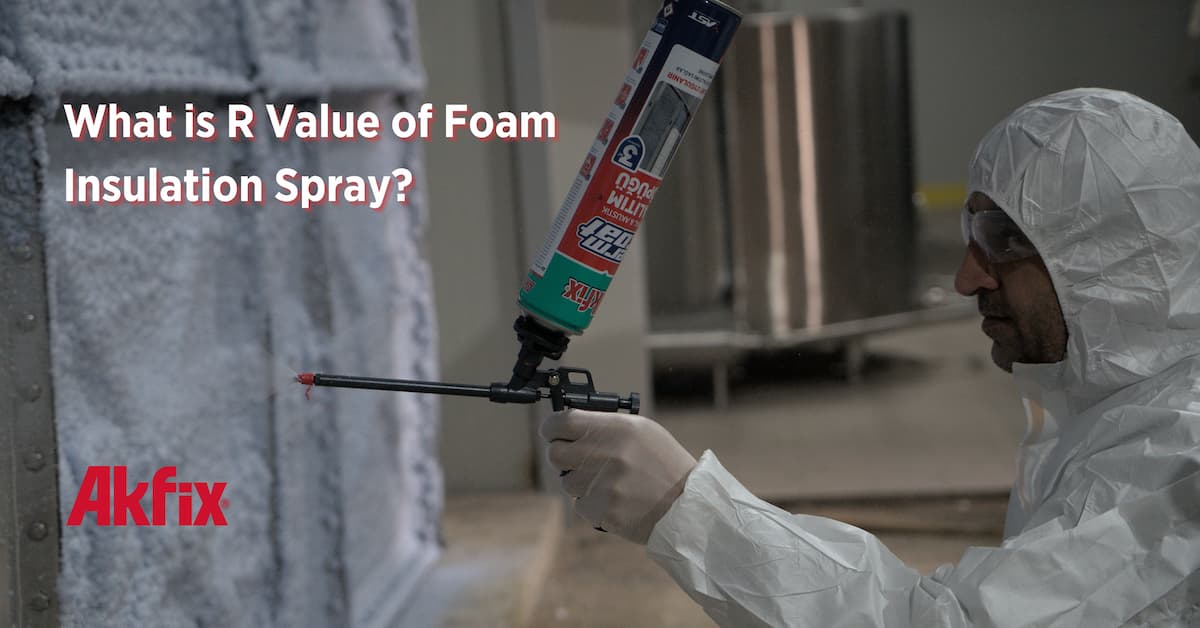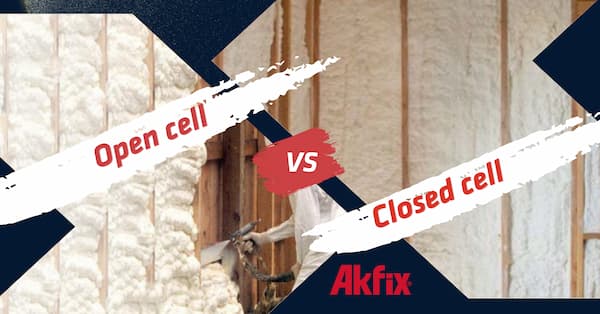A home in Alaska cannot have the same R-value insulation as a house in Virginia. Knowing the right R-value that is most convenient for your home is just as important as insulating your home. In this article, you will understand everything about R-value, factors affecting R-value, the R-Value insulation chart, and the two types of spray foam Insulation.
What is R-Value?
The letter R simply means Resistance. The resistance value (R-value) denotes the measure of resistance to heat flow of the insulation used in a building. The higher the R-value of insulation used, the more effective the insulation is.
R-value is addictive in the sense that the more the insulation used, the more the R-value. Therefore, when you add different materials with an R-value of both 12 and 6, respectively, the total R-value of the materials becomes 18.

How Insulation Works?
Heat is transferred from a region of high temperature to an area of lower temperature till there is equilibrium. Heat transfer occurs in three ways: conduction, convection, and radiation. Knowing the three ways heat is transferred is essential to understand how insulation works.
When heat is transferred through materials such as metals and spoons, it is known as Conduction. Convection occurs when there is heat transfer through liquids and gases. Radiation is the transfer of radiant heat on a straight line on any solid that absorbs heat. UV rays from the sun are a good example of radiation.
Insulation resists heat transfer from higher temperature (surroundings) to lower temperature (indoor). The conductive and convective heat flow between the environment and the building is slowed down by applying insulation materials in the house.
During winter, the little heat available in the house is lost to the surrounding environment through attics, windows, and little spaces around the house. Also, heat is gained in the house from the surrounding environment through the same spaces around the house during summer.
During summer, the Air conditioning system removes heat gained in the house. Also, the heat lost during winter is added by the Heating system. Insulation simply reduces the heat flow between the home and the environment, thereby reducing the energy consumed by the HVAC system to achieve a balanced temperature.
What Is The Amount Of Insulation Or R-Value You Need?
The amount of R-value on insulation needed for your home, attic, or walls depends on factors like Climate, the type of HVAC system in your home, and the part of the home that requires insulation. Different climates will require an additional R-value for insulation recommendation.
R-Value Chart For USA
Knowing the right R-value for your house depends on your climate, type of heating system, and part of the home. Using the map, you can find your zone and then use the spray foam R-value chart to determine the right R-value insulation for different parts of your house.

|
Insulation R-Values for Location, Heat Type, and Area |
|
Location |
Heat Type |
Wall |
Floor |
Crawl Space Wall |
Basement Wall |
|
|
Zone 1 |
Natural Gas |
38-49 |
13 |
13 |
13 |
11 |
|
Oil Furnance |
38-49 |
13 |
13 |
13 |
11 |
|
|
Electric Furnance |
38-49 |
13 |
13 |
13 |
11 |
|
|
Electric BaseBoard |
38-49 |
13 |
13 |
13 |
11 |
|
|
Heat Pump |
38-49 |
13 |
13 |
13 |
11 |
|
|
LPG Furnance |
38-49 |
13 |
13 |
13 |
11 |
|
Location |
Heat Type |
Wall |
Floor |
Crawl Space Wall |
Basement Wall |
|
|
Zone 2 |
Natural Gas |
38 |
13 |
13-19 |
13 |
11 |
|
Oil Furnance |
38 |
13 |
13-19 |
13-25 |
11 |
|
|
Electric Furnance |
38-49 |
13 |
19-25 |
25 |
11 |
|
|
Electric BaseBoard |
38-49 |
13 |
13-25 |
13-25 |
11 |
|
|
Heat Pump |
38 |
13 |
13-19 |
13 |
11 |
|
|
LPG Furnance |
38-49 |
13 |
19-30 |
25 |
11 |
|
Location |
Heat Type |
Attic |
Wall |
Floor |
Crawl Space Wall |
Basement Wall |
|
Zone 3 |
Natural Gas |
30-38 |
13 |
13-19 |
13-25 |
11 |
|
Oil Furnance |
38 |
13 |
13-19 |
13 |
11 |
|
|
Electric Furnance |
38 |
13 |
13-19 |
13-25 |
11 |
|
|
Electric BaseBoard |
38 |
13 |
13-19 |
13 |
11 |
|
|
Heat Pump |
30-38 |
13 |
13 |
13 |
11 |
|
|
LPG Furnance |
38-49 |
13 |
13-30 |
13-25 |
11 |
|
Location |
Heat Type |
Attic |
Wall |
Floor |
Crawl Space Wall |
Basement Wall |
|
Zone 4 |
Natural Gas |
38-49 |
13 |
25-30 |
25 |
11 |
|
Oil Furnance |
49 |
13 |
30 |
25 |
11 |
|
|
Electric Furnance |
38-49 |
13 |
25-30 |
25 |
25 |
|
|
Electric BaseBoard |
49 |
13 |
30 |
25 |
11 |
|
|
Heat Pump |
38-49 |
13 |
13-25 |
13-25 |
11 |
|
|
LPG Furnance |
49 |
13 |
30 |
25 |
11-25 |
|
Location |
Heat Type |
Attic |
Wall |
Floor |
Crawl Space Wall |
Basement Wall |
|
Zone 5 |
Natural Gas |
38 |
13 |
25 |
25 |
11 |
|
Oil Furnance |
49 |
13 |
30 |
25 |
11-15 |
|
|
Electric Furnance |
49 |
13 |
30 |
25 |
25 |
|
|
Electric BaseBoard |
49 |
13 |
30 |
25 |
11 |
|
|
Heat Pump |
38 |
13 |
30 |
25 |
11 |
|
|
LPG Furnance |
49 |
13 |
30 |
25 |
25 |
|
Location |
Heat Type |
Attic |
Wall |
Floor |
Crawl Space Wall |
Basement Wall |
|
Zone 6-8 |
Natural Gas |
38 |
13 |
30 |
25 |
25 |
|
Oil Furnance |
49 |
13 |
30 |
25 |
25 |
|
|
Electric Furnance |
49 |
13 |
30 |
25 |
25 |
|
|
Electric BaseBoard |
49 |
13 |
30 |
25 |
25 |
|
|
Heat Pump |
38 |
13 |
30 |
25 |
25 |
|
|
LPG Furnance |
49 |
13 |
30 |
25 |
25 |
What Is The Foam Insulation Spray R-Value
One of the most reliable methods of insulation is Spray Foam Insulation. Spray foam insulation or polyurethane foam Insulation is the use of liquid foam to insulate walls, ceilings, basement walls, windows, garage doors, etc.
Spray foam is versatile in usage and is the best insulation in reaching places that are difficult to reach. Of all the insulation methods available, the R-value of spray foam insulation is one of the highest, making it a very effective insulation method used in construction compared to rigid insulation or other types of insulation.
There are two types of spray foam Insulation: Closed-cell Spray foam Insulation and Open-cell Spray foam Insulation. For attic insulation, both types of insulation are effective. The difference between them is their respective R-values and their physical makeup after installation.

Closed Cell Foam R-value
Closed cell foam R-value is the higher one of both types of insulation and even other types of insulation like fiberglass, rigid foam insulation, and cellulose. Closed cell spray foam is applied to provide an excellent air barrier, retard vapor, and retain moisture in the home.
In terms of higher R-value, the rigid foam insulation R-value is lesser than closed-cell with an R-value of R3.6 - R4.0 per inch. The closed-cell foam R-value is between R5.66 - R8.0 per inch. Our closed-cell spray foam insulation R-value per inch has an R-value of R5.66 per inch and is effective for sealing air leaks in your home. Also, the closed-cell spray foam is used to insulate ceilings, walls, and roofs.
Open Cell Foam R-value
Open cell foam has a lower density than closed cell foam but can also be used to insulate ceilings, walls, and roofs. Unlike closed-cell foam that retards vapor, open-cell foam is vapor permeable. Open-cell foam R-value is between the range of R3.5 - R3.6 per inch.
Open-cell foam spray expands and can reach a depth of 3inches. The installer can adjust the depth with the minimum depth being 1.5 inches while the maximum is 3 inches. Filling a 2x4 wall with a thickness of 3 inches, the spray foam insulation R-value 2x4 yields an R13, and it can be done using Open-cell Foam. Open-cell has excellent acoustics, which makes it a good choice to soundproof your home.


